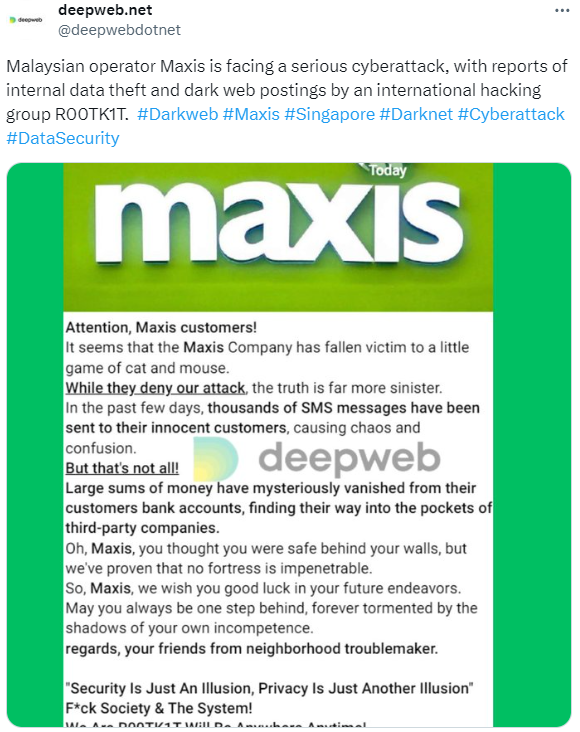
Despite Kaspersky’s efforts blocking 22 million cyberthreats in 2023, Malaysia faces ongoing hacker threats. (Source – Kaspersky).
Kaspersky blocked 22 million cyberthreats in Malaysia in 2023
- Despite a slight decrease in Malaysia’s cyberthreats in 2023, with 22 million incidents blocked, the R00TK1T attack on Maxis shows hackers remain a formidable challenge.
- The R00TK1T incident against Maxis highlights the constant threat of targeted cyberattacks.
- Malaysia sees a decline in cyberthreats in 2023, but more sophisticated attacks demanding stronger defenses.
The specter of cyberthreats looms, casting a shadow over nations striving to fortify their digital defenses. Malaysia, a burgeoning hub of technological innovation and digital expansion, finds itself at the crossroads of this ongoing battle against cyber malfeasance. With the rise of internet connectivity and digital services, the country has become a fertile ground for cybercriminal activities, prompting an urgent need for comprehensive cybersecurity measures.
Against this backdrop, Kaspersky, a cybersecurity company, has shed light on the evolving nature of local cybersecurity threats in Malaysia, tracing developments over a three-year span. According to its recent report, there has been a slight but consistent decline in cybersecurity threats from 2021 to 2023, indicating a somewhat positive trend in the battle against digital malfeasance.
Kaspersky was active in fighting cyberthreats in 2023
Predominantly, worms and file viruses emerge as the chief culprits, with the Kaspersky Security Network (KSN) revealing how users frequently fall prey to malware spread through removable USB drives and other offline methods. This underscores the persistent need for a multifaceted security approach that integrates antivirus solutions, firewalls, anti-rootkit tools, and stringent controls over removable devices.
In the past year alone, Kaspersky’s efforts have led to the successful neutralization of 22,037,248 local threats aimed at Malaysian users, marking a modest reduction of 0.43% from the previous year’s figures:
- 2021: 35,873,395 local threats
- 2022: 22,133,174 local threats
- 2023: 22,037,248 local threats
This significant reduction in local threats since 2021, a year also noted by INTERPOL for a surge in cybercrime activities, highlights the ongoing challenges and successes in cybersecurity efforts. Cybercriminal syndicates continue to refine their strategies, utilizing shared resources and expertise to launch sophisticated attacks.
Yeo Siang Tiong, Kaspersky’s general manager for Southeast Asia, emphasizes the critical importance of cyber hygiene for individuals and corporations alike. He notes that many threats require human interaction to succeed, pointing out the risks associated with employees circumventing security protocols—a factor as detrimental as external hacking attempts.
Echoing this sentiment, the CyberSecurity Malaysia Mid-Year Threat Landscape Report for 2023 advocates for strengthening cybersecurity infrastructures and adopting continuous monitoring, training, and best practices. It highlights the manufacturing sector as particularly vulnerable to ransomware attacks, followed closely by the educational sector and others.
Despite the observed decline in local threats, Yeo warns against complacency, pointing out the shift in cybercriminal tactics towards more targeted attacks rather than broad campaigns. Kaspersky experts recommend a comprehensive set of cyberhygiene practices to fortify digital defenses.
The R00TK1T incident: a stark reminder of emerging cybersecurity challenges
Amidst this broader cybersecurity landscape, the telecommunications giant Maxis faced a formidable challenge from the hacker collective R00TK1T. Following Maxis’ disclosure of a cybersecurity breach, R00TK1T disputed the company’s claim that only third-party vendor systems were affected, demanding acknowledgment of the breach’s full extent and threatening further disruptions.
R00TK1T’s claim of infiltrating a Maxis employee’s internal dashboard casts doubt on the company’s cybersecurity defenses and presents a stark ultimatum: acknowledge the breach or face escalated attacks. The group’s assertion of compromising Maxis’ Kulim Network and the potential reset of Agrotech-related systems illustrates the sophisticated nature of modern cyber threats.
As R00TK1T ramps up its threats, showcasing a screenshot that purportedly displays network connections at Quayside Mall in Kota Kemuning, the group’s capability to infiltrate critical infrastructure becomes evident. With an “elite squad” of 52 highly skilled individuals, R00TK1T’s actions represent a significant challenge to Malaysia’s digital security.
Maxis’ response, focusing on customer privacy and security, underscores the complexities of safeguarding digital ecosystems. The incident, meticulously documented by R00TK1T, including screenshots from a purported Maxis user database, highlights the intricacies of protecting sensitive data in an interconnected world.

Maxis is facing a serious cyberattack. (Source – X).
Strengthening cyberdefenses in an evolving digital landscape
This juxtaposition of general cybersecurity trends with the specific R00TK1T incident against Maxis offers valuable insights into the multifaceted nature of cyberthreats in Malaysia. As the nation enhances its cyber-awareness and preparedness, incidents like these serve as critical reminders of the persistent challenges in securing digital infrastructure and sensitive information.
The government’s commitment to bolstering cybersecurity through budget allocations and the expansion of 5G network coverage reflects a proactive approach to technological advancement and security. But as cyberthreats continue to evolve, the need for comprehensive cyberhygiene practices, robust security measures, and a collective effort in cybersecurity education and infrastructure development remains paramount.
In navigating the complex cybersecurity landscape, the collective efforts of cybersecurity firms, corporations, and government agencies are crucial. The ongoing battle against cyberthreats as seen in 2023 demands technological solutions and a strong culture of cyberhygiene and awareness among individuals and organizations alike. The case of R00TK1T’s confrontation with Maxis is a potent reminder of the ever-present risks in the digital domain and the need for vigilance and proactive measures.
Educating employees on the importance of following security protocols, implementing robust security technologies, and fostering a collaborative approach to cyberdefense can significantly reduce the risk of breaches. Continuous monitoring, rapid response strategies, and threat intelligence sharing within and across sectors are essential components of a resilient cybersecurity posture.
The evolving nature of cyberthreats, exemplified by targeted attacks from groups like R00TK1T, underscores the importance of adaptive security strategies that can anticipate and mitigate emerging risks. As cybercriminals employ increasingly sophisticated methods, the security community must stay ahead by leveraging advanced technologies, such as artificial intelligence and machine learning, for threat detection and response.
In conclusion, the cybersecurity landscape in Malaysia, as observed through the trends reported by Kaspersky and the specific incident involving R00TK1T and Maxis, reflects the broader global challenge of securing digital infrastructures against relentless and evolving threats. It highlights the imperative for a comprehensive and dynamic approach to cybersecurity, combining technological solutions, human factors, and collaborative efforts to safeguard the digital future. As Malaysia continues to advance its digital infrastructure, the lessons learned from these experiences will be invaluable in shaping a secure and resilient cyber-environment for all.
READ MORE
- Safer Automation: How Sophic and Firmus Succeeded in Malaysia with MDEC’s Support
- Privilege granted, not gained: Intelligent authorization for enhanced infrastructure productivity
- Low-Code produces the Proof-of-Possibilities
- New Wearables Enable Staff to Work Faster and Safer
- Experts weigh in on Oracle’s departure from adland




